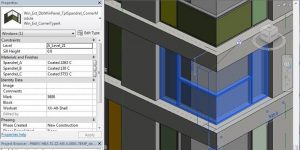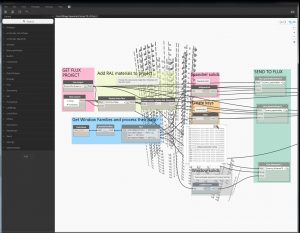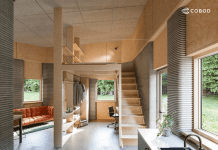Award-winning architectural studio Hawkins/Brown has embraced BIM not simply as a new type of software but as a way of fundamentally changing the way in which projects are designed and delivered. Nathaniel Rackham, the firm’s BIM manager, discusses the journey so far
In just over four years, we have moved from delivering three projects through Building Information Modelling (BIM) to servicing over 60, several of which are full Level 2 projects requiring an Asset Information Model (AIM).
Back in 2015 Hawkins\Brown made a conscious decision to invest in BIM and chose Autodesk Revit to assist in the delivery of all above ground projects and Bentley MicroStation for its infrastructure work, such as Crossrail.
The firm soon realised that BIM wasn’t (and isn’t) a piece of software but a paradigm shift in the way practices and projects are managed and delivered and, to that extent, appointed a BIM manager to put in place the necessary office standards, documentation, templates, content libraries and, most importantly, a strategy for staff training (both in the software itself and the changes to the management/resourcing of projects that is often overlooked or not considered).
Once the aforementioned was in place, training sessions were run each week in a variety of core areas. Training was provided by our long-term BIM consultants, InfiniteBIM, meaning that staff were trained in the same way. This consistent approach was vital in maintaining a common ‘best practice’ series of workflows for the production of a model/package information.
As the number of projects grew across the practice, teams delivering projects in traditional CAD software began to see the benefits of working in a BIM-enabled environment.
One such benefit was the ability to append data to the geometries that were being designed. Rather than using CAD to draw the components of a door as a set of lines, teams were able to allocate data to a 3D component. The model knows that the door is a certain size, what ironmongery it is fitted with, its finish and colour etc.
Teams were able to generate schedules automatically, to feed into cost and programme information and to inform a client of the FM requirements of the door. If a door was deleted from the model as part of a design change, it would no longer appear in the schedules or in any other drawn output from the model – all of which is now well understood by the industry. What we believe to be less understood is that the process can also work in the other direction, in that the data can influence the design/geometry.
This is an entirely new set of skills for architects to master. A new way of drawing, modelling or designing – through coding. Not only can we manipulate the data that constitutes our design but, through APIs and built-in coding interfaces, we can also manipulate the capabilities of the software that we are using. No longer are we at the mercy of the buttons that Autodesk gives us – we can build our own.

Designing through coding requires a new set of skills for architects to master, however, and it is no surprise that many leading architectural practices now have their own computation design team or specialist consultants.
We are already seeing several projects in the office benefit from this. One of the first forays into the potential of coding was for the Here East project, where we developed a unique ‘dazzle-ometer’ code that allowed us to rapidly optioneer unique designs of glass frit patterns for the building facade, while fixing the solar control performance. Once a pattern was chosen, the code was then used to automate the setting out of every single dot that made up the frit.
Similarly, for the University of Sussex, we developed a code to set out a doubly curved wave of pendant light fittings. This enabled the designer to massage the curvature of the light wave and the grid of pendants, using a tangible set of control points and see the results instantly in 3D.
More recently, we’ve been working on a façade colour pattern code dubbed the ‘spandrel-iser’. This script was used for the East Village project and enabled the design team to rapidly test different colour palettes and percentage mixes of colour for over 3,000 spandrel panels. A manual process that would have likely taken one individual weeks to develop a single iteration, became live. The design team could tweak the mixes and watch the 3D model instantly update.
It was these sorts of examples that led us to realise scripting could also remove many of the repetitive day-to-day tasks that staff don’t appreciate. The auditing of files prior to Information Exchange, the embedding of Uniclass into our families, applying revisions to several hundred drawings for a package issue, family renaming and so on could all be automated and it was this approach that helped us win the coveted AJ100 Best Use of Technology in 2018.
By delivering all new projects in a BIM-enabled environment, Hawkins\Brown appreciates that the data within the models can be harvested in such a way that separate projects can be spawned, affording both the practice and its clients key benefits.

This approach has led to the creation of our Emission Reduction Toolkit known as H\B:ERT, which enables design teams to quickly analyse and clearly visualise the embodied carbon emissions of different building components and construction materials at any time during the design process, allowing easy and robust comparisons between previous/current designs/projects and sets the grounds for a complete lifecycle carbon footprint analysis. (The H\B:ERT is free to download from our website and sits within Revit as a plugin).
Another example is the creation of our Project Briefing Tool, which assists us in developing client briefs based on our previous projects. In the latest plan of work, RIBA intrinsically linked Stage 7 (In Use) with Stage 0 (Strategic Definition). This means that analysis of existing projects should inform future briefs and buildings. By standardising all our previous space data, we are able to build briefs from accurate and reliable quantitative parameters, which can be tailored to user populations, allowing us to minimise the risk of abortiv work and ultimately streamline the process.
Furthermore, the tool is cloud-based, allowing us to communicate with clients ‘live’ on site or remotely, tweaking the brief as a team.
BIM is undoubtably the future for the construction industry and affords us almost limitless possibilities through the advancement of technology and innovative thinking. This, combined with robust government standards, provides us with a framework in which project efficiencies can be achieved while also providing a first-class product for clients. Our recent BIM Level 2 certification award with the BSI as a Tier 1 contractor merely confirms our commitment and demonstrates our genuine capability and capacity to deliver projects.
Nathaniel Rackham
BIM Manager & Associate
Tel: +44 (0)20 7336 5749
NathanielRackham@hawkinsbrown.com
Twitter: hawkins_brown
YouTube: Hawkins\Brown
Instagram: hawkins_brown














